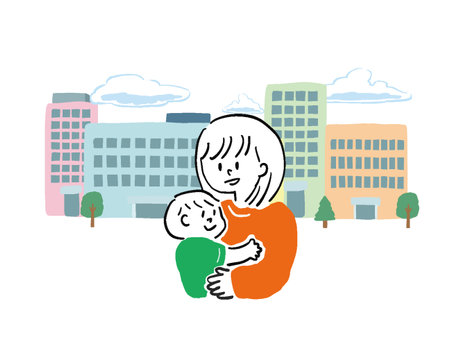1. Understanding Your Childcare Needs
Finding the right childcare option starts with understanding your familys specific needs. Every family has unique circumstances, so taking the time to evaluate your situation will help you choose the best solution for your child and your work-life balance.
Assess Your Familys Unique Needs
Consider your childs age, personality, and any special care requirements. Younger children may need more hands-on attention, while older kids might benefit from a structured learning environment.
Evaluate Your Work Schedule
Your job schedule plays a big role in determining which childcare option works best. Do you have a traditional 9-to-5 job, or do you work irregular hours? Here’s a quick comparison of childcare options based on different work schedules:
| Work Schedule | Recommended Childcare Options |
|---|---|
| Traditional 9-to-5 | Daycare centers, preschools, nanny services |
| Shift Work/Irregular Hours | Nannies, babysitters, family care, 24-hour daycare |
| Remote Work | Part-time nanny, parent co-ops, flexible daycare programs |
Consider Your Budget
The cost of childcare varies widely depending on location and type of care. Some families prefer in-home care like nannies or babysitters, while others opt for more affordable group settings like daycare centers or family-based childcare. Make sure to compare costs and look into financial assistance programs if needed.
Your Parenting Preferences Matter
Your parenting style and values should align with your chosen childcare provider. Some parents prioritize educational programs, while others focus on a nurturing home-like environment. Consider what matters most to you when making a decision.
2. Exploring Different Childcare Options
Finding the right childcare solution is essential for balancing work and family life. There are several options to consider, each with its own advantages and challenges. Below, we compare some of the most common childcare choices to help you determine the best fit for your familys needs.
Daycare Centers
Daycare centers provide a structured environment where children can learn and socialize with others. They are often staffed by trained professionals and follow a set curriculum.
Pros:
- Structured learning environment
- Socialization opportunities for children
- Licensed and regulated facilities
Cons:
- Fixed hours may not be flexible for all work schedules
- Larger groups mean less individualized attention
- Higher costs in some areas
In-Home Daycare
An in-home daycare is run by a caregiver in their own home, offering a smaller and more personal setting compared to daycare centers.
Pros:
- A home-like atmosphere that may feel more comfortable for young children
- A smaller group size allows for more personalized care
- Tends to be more affordable than daycare centers
Cons:
- Might not have the same level of structure or curriculum as daycare centers
- The quality of care varies depending on the provider
- If the caregiver is unavailable (e.g., sick days), backup care may be needed
Nannies
A nanny provides one-on-one care in your home, offering personalized attention and flexibility.
Pros:
- Your child receives individualized attention
- A flexible schedule tailored to your needs
- No need for drop-offs or pick-ups
Cons:
- The most expensive childcare option in many cases
- You become an employer, responsible for payroll and taxes
- If the nanny quits unexpectedly, finding a replacement can be challenging
Babysitters
A babysitter typically provides occasional care, often during evenings or weekends, rather than full-time daily care.
Pros:
- A good option for short-term or occasional care needs
- Tends to be more affordable than full-time nannies or daycare centers
- You can hire them on an as-needed basis
Cons:
- Lack of consistency if using multiple babysitters
- Might not have formal childcare training or certifications
- Might not provide structured learning activities like other options do
Au Pairs
An au pair is a young person from another country who lives with your family and provides childcare in exchange for room, board, and a stipend.
Pros:
- Cultural exchange experience for both the child and family
- An affordable live-in childcare option compared to nannies
- The caregiver becomes part of your household, providing built-in support
Cons:
- The arrangement typically requires providing room and meals for the au pair
- A limited number of hours per week based on program regulations
- Potential cultural differences that require adjustment from both sides
Comparison Table of Childcare Options
| Childcare Option | Main Benefits | Main Drawbacks | Ideal For… |
|---|---|---|---|
| Daycare Centers | A structured learning environment with social opportunities | Larger class sizes, less flexibility | Prenursery-aged children needing socialization |
| In-Home Daycare | A home-like setting with smaller groups | Lack of backup care if provider is unavailable | Younger children who thrive in small groups |
| Nannies | One-on-one care at home with flexible hours | High cost; employer responsibilities | Families needing full-time personalized care |
| Babysitters | Flexible, short-term childcare when needed | Not always available on short notice; inconsistent caregivers | Parents needing occasional or last-minute help |
| Au Pairs | Cultural exchange opportunity; live-in support | Limited working hours; requires providing housing & meals | Families open to cultural exchange seeking affordable live-in care |
Choosing the right childcare option depends on factors such as budget, schedule flexibility, and your child’s specific needs. Understanding these different solutions can help you make an informed decision that supports both your career and family life.

3. Evaluating Quality and Safety Standards
Choosing the right childcare provider is not just about convenience—it’s about ensuring your child is in a safe, nurturing, and high-quality environment. Here are key factors to consider when evaluating childcare options.
Licensing and Accreditation
A reputable childcare provider should be licensed by the state and, ideally, accredited by a recognized organization such as the National Association for the Education of Young Children (NAEYC). Licensing ensures that the facility meets basic health and safety requirements, while accreditation signifies a higher level of quality in care and education.
Caregiver Qualifications
The experience and training of caregivers play a crucial role in your child’s development. Look for providers with staff who have:
- Early childhood education or relevant certifications
- CPR and first aid training
- Background checks and references
- A low caregiver-to-child ratio for personalized attention
Safety Protocols
A safe environment is essential for your child’s well-being. When visiting a childcare center or interviewing a provider, ask about their safety policies, including:
| Safety Aspect | What to Look For |
|---|---|
| Emergency Preparedness | Fire drills, emergency exits, and clear evacuation plans |
| Cleanliness & Hygiene | Sanitized toys, handwashing routines, and illness policies |
| Security Measures | Coded entry systems, visitor sign-in procedures, and supervision protocols |
| Nutritional Standards | BALANCED MEALS AND ALLERGY ACCOMMODATIONS |
Trusting Your Instincts
No checklist can replace your intuition. If something feels off during a visit or conversation with a provider, trust your gut. A great childcare provider should make you feel confident that your child will be safe, happy, and well cared for.
4. Balancing Flexibility and Affordability
Finding the right childcare option means balancing both flexibility and affordability while ensuring your child receives reliable and high-quality care. Every family’s needs are different, so it’s important to evaluate options that fit within your budget and work schedule.
Understanding Your Childcare Needs
Before choosing a childcare option, consider your work hours, commute time, and backup care plans. Some jobs require fixed schedules, while others may have unpredictable hours. Identifying these factors will help you determine whether you need full-time daycare, part-time care, or a more flexible arrangement like in-home care.
Comparing Childcare Costs and Flexibility
The cost of childcare can vary widely depending on the type of care you choose. Here’s a quick comparison of common childcare options:
| Childcare Option | Cost | Flexibility | Best For |
|---|---|---|---|
| Daycare Centers | $$ – $$$ | Fixed Hours | Parents with regular work schedules |
| In-Home Daycare | $ – $$ | Semi-Flexible | Parents looking for a home-like setting |
| Nanny or Babysitter | $$$ – $$$$ | Highly Flexible | Parents needing customized schedules |
| Nanny Share | $$ – $$$ | Semi-Flexible | Families wanting personalized care at a lower cost |
| Family Support (Relatives, Friends) | $ (Often Free) | Very Flexible | Parents with available family support network |
Tips for Finding Affordable Yet Flexible Childcare
1. Explore Employer Benefits and Assistance Programs
Some employers offer childcare assistance programs, flexible spending accounts (FSAs) for dependent care, or even on-site daycare. Check with your HR department to see if any benefits are available.
2. Consider Part-Time or Shared Care Options
If full-time care is too expensive, you might opt for part-time daycare or share a nanny with another family. These options allow you to split costs while still receiving quality care.
3. Look for Subsidies and Community Resources
Certain government programs and local organizations provide financial assistance for childcare. Visit resources like Child Care Aware of America (www.childcareaware.org) to explore subsidy options.
4. Plan Ahead and Compare Providers
The earlier you start researching childcare providers, the more options youll have to compare prices and flexibility. Waiting until the last minute may limit your choices and increase costs.
A Balanced Approach to Work-Life Harmony
Your ideal childcare choice should support both your career and family life without causing financial strain. By weighing flexibility against affordability, you can find a solution that allows you to focus on work while knowing your child is in safe hands.
5. Making the Transition Smooth for Your Child
Starting childcare is a big step for both you and your little one. Adjusting to a new environment, routine, and caregivers can take time, but there are ways to make the transition easier. Here are some practical tips to help your child feel comfortable and secure in their new childcare setting.
Preparing Your Child for the Change
Before the first day, take steps to familiarize your child with their new surroundings. This can ease anxiety and create a sense of comfort.
- Visit the childcare center together: Spend some time exploring the space, meeting caregivers, and playing with toys.
- Talk about what to expect: Use simple language to explain what will happen during the day, who will be there, and when youll return.
- Practice separation: If possible, leave your child with a trusted caregiver for short periods before starting childcare.
Building a Positive Relationship with Caregivers
A strong relationship between you and your childs caregivers helps create a supportive environment. Open communication and trust are key.
| Ways to Build Trust | How It Helps |
|---|---|
| Introduce yourself personally | Makes caregivers feel like part of your support system. |
| Share important details | Helps them understand your childs preferences, routines, and any special needs. |
| Express appreciation | Encourages positive interactions and strengthens the caregiver-parent relationship. |
Maintaining Open Communication
Keeping an open line of communication with caregivers ensures that everyone is on the same page regarding your childs well-being.
- Ask about daily updates: Check in with caregivers about meals, naps, activities, and mood changes.
- Address concerns early: If you notice any issues or have questions, talk to the caregiver promptly to find solutions together.
- Create a routine for drop-offs and pick-ups: A consistent schedule helps your child feel secure and know what to expect each day.
Helping Your Child Feel Secure
The transition period may come with tears or hesitation, but consistency and reassurance can make all the difference.
- Bring a comfort item: A favorite stuffed animal or blanket can provide emotional security during the adjustment period.
- Saying goodbye with confidence: Keep goodbyes short and upbeat to show your child that they are safe and loved.
- Acknowledge emotions: Let your child express their feelings while reassuring them that youre always coming back.
The transition to childcare takes time, but with patience, preparation, and communication, your child will gradually feel comfortable in their new environment. Every child adjusts at their own pace—stay supportive, and soon enough, they’ll thrive in their new routine!


